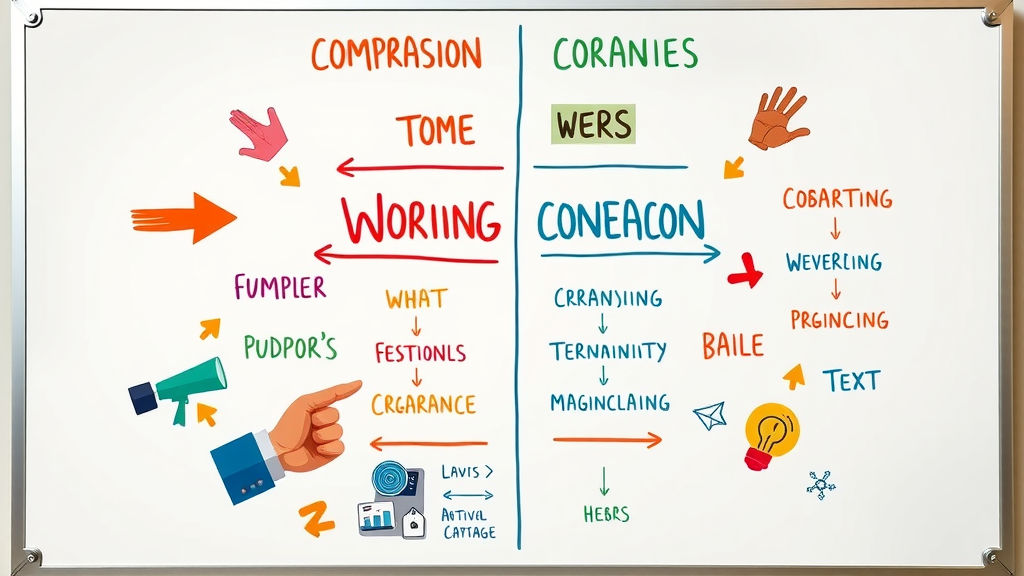Did you know that consistent brand tone and style can increase revenue by up to 23% ? In a world where consumers are constantly bombarded with marketing messages, instantly recognizing—and remembering—your brand demands more than a great logo. It’s about a masterful blend of brand tone and style that makes every touchpoint unmistakably yours. In this article, you’ll discover why a strong, consistent approach to brand tone and style is essential for success, proven steps to define your unique voice, and real-world examples to inspire your next move.

Uncover Why Brand Tone and Style Are Critical in Today’s Crowded Marketplace
- Did you know that consistent brand tone and style can increase revenue by up to 23%? In an era where consumers face brand messaging overload, mastering your brand tone and style is your shortcut to creating instant recognition and long-term trust.
In today's crowded marketplace , standing out isn't just about a memorable logo or catchy slogan. The true magic lies in how consistently you communicate—your brand tone and style set the stage for every interaction. When every blog post, tweet, or customer service response “sounds” like you, customers immediately recognize your voice. This instant recognition translates into deeper trust, improved loyalty, and even increased revenue. Just consider the psychological impact of encountering a brand that always feels the same: it reassures, builds credibility, and fosters an emotional connection that random, inconsistent messaging simply cannot.
Brands that master their brand tone, style guide, and brand strategy rise above the noise. Whether you’re launching a startup or rebranding a global corporation, the way you communicate—and the consistency across all touchpoints—tells your audience what to expect. In fact, research shows that brands with a strong brand voice outperform competitors in customer recognition and recall. If you want your brand to immediately stand out and resonate on every communication channel, it all begins with defining, refining, and mastering your brand tone and style.
How to Use Brand Tone and Style for Memorable, Recognizable Messaging

Defining Brand Tone and Style: Key Differences and Intersections
- Explore the definitions and unique roles of brand tone and style, including their overlap with tone of voice, brand voice, voice and tone, and brand persona.
Brand tone is the emotional flavor or attitude your brand conveys through words and messaging, while brand style encompasses the visual and linguistic choices that give your communication its signature “look and feel.” Though often used together, each serves a distinct function: tone shapes how your messages are perceived emotionally, style organizes the way those messages are presented. The foundation of a brand voice sits at the crossroads of tone and style—it’s the overarching personality consistently expressed in all communications, from content marketing and social media to product descriptions.
It’s important to understand the overlap between these elements. For example, your tone of voice might be playful, authoritative, or empathetic, while your style guide sets rules for grammar, formatting, and visuals. Meanwhile, your brand persona gives life to these concepts by personifying your brand, helping to create content and develop messages that feel authentically you. Ultimately, consistent application of these principles ensures every piece of content aligns with both your brand’s core values and the expectations of your target audience.
This intersection—where brand tone, style guide, and voice guidelines meet—is the heart of brand identity . Successful brands map out these elements, often in a comprehensive brand guide or voice guide , to ensure consistency and clarity across all communication channels. By defining your brand through these touchpoints, you build a solid foundation for brand strategy and long-term audience trust.
Why Consistent Brand Tone and Style Matter for Brand Identity
- Discuss how consistency in brand tone and style is the foundation of a strong brand identity, influencing perception, credibility, and audience trust.
Consistency in brand tone and style is the backbone of a strong brand identity . When every piece of content reflects the same personality—whether it’s an email newsletter, website landing page, or TikTok campaign—your audience starts to recognize and trust your brand. This is not an accident, but the result of a strategic and deliberate approach built around a style guide and regular training for your internal teams.
A consistent brand voice suggests reliability, professionalism, and attention to detail. It transforms a business from a faceless entity into a relatable, trustworthy partner for its customers. Branding is inherently psychological; people gravitate toward brands that make them feel understood and valued. Consistent tone and style deliver on those expectations, building familiarity and confidence with each interaction and reinforcing your commitment to quality.
That’s why the world’s most successful companies treat their brand voice and tone as a core part of their brand strategy . Their teams follow a precise set of voice guidelines—setting clear boundaries on what is and isn’t “on-brand.” By integrating these principles across every communication channel, businesses foster deeper engagement, stronger loyalty, and an unmistakable position in the marketplace.

The Psychological Impact of Brand Voice, Tone and Style on Your Target Audience
- Analyze the emotional triggers, consumer psychology, and behavioral outcomes shaped by voice and tone, drawing on real data and practical examples.
The way you express your brand tone and style profoundly shapes how your target audience perceives—and interacts with—your brand. Emotionally resonant messaging taps into fundamental psychological triggers: trust, excitement, empathy, and aspiration. For instance, a brand that uses a conversational tone and approachable style can make customers feel welcomed and valued, while a more authoritative voice may instill confidence in a brand’s expertise.
Data shows that consumers are more likely to engage with brands that sound authentic and relatable. A study by Sprout Social revealed that 86% of people prefer a brand that’s honest, friendly, and helpful in its communication. When your brand consistently hits the same emotional notes, you encourage positive behavioral outcomes—like loyalty, advocacy, and repeat purchase. Practical examples abound: small businesses that humanize their messaging through personal anecdotes or humor build stronger bonds than those using generic, impersonal statements.
Beyond sparking emotional connection, the psychological value of consistency is often overlooked. Knowing what to expect—whether in tone, format, or content—offers comfort and reduces decision fatigue, which drives more confident interactions. So, every adaptation or update to your brand guide and voice guideline should be viewed as an opportunity to create deeper, lasting impressions that result in long-term customer relationships.
How Brand Tone and Style Drive Instant Recognition
- Break down the neuroscience of recognition, highlighting how a well-crafted brand tone of voice ensures your brand stands out and is memorable.
Instant recognition happens when your audience can identify your brand in just a few words, images, or even a single phrase. Neuroscience tells us that humans are wired to recognize patterns—consistent repetition of sounds, visuals, and feelings triggers memory recall and strengthens brand associations. When your brand tone of voice is unique and immediately recognizable, every interaction moves you closer to becoming top-of-mind in your audience’s daily life.
Think about the world’s most iconic brands: you can spot their tone, catchphrases, and visual style in a sea of advertisements because these brands have methodically repeated their promise and personality. Distinctive brand tone also allows for agility; as trends change, your unique style can evolve without losing its core essence, ensuring ongoing relevance and recognizability. Even across multiple communication channels—social media, ads, and customer service—the same recognizable cues prompt automatic connections in your customers’ minds.
In practical terms, this kind of familiarity builds preference and loyalty. With thousands of brands vying for attention, a memorable brand voice and tone deliver differentiation, anchoring your brand firmly in the consciousness of your audience and making every interaction an opportunity for lasting engagement.
Creating and Implementing Your Brand Tone and Style Guide

Step-by-Step Guide: Define Your Brand Tone, Voice, and Style
- Walk through mapping your brand personality, building a brand persona, and establishing guiding principles for an effective brand tone and style guide.
The journey toward a consistent brand voice begins by mapping your brand personality —the set of human characteristics that define your business. Start by asking big-picture questions: What are your brand values? How do you want to make people feel? Next, build a brand persona —a fictional “face” of your company that embodies your tone of voice and style in all communications. This persona will help you and your team “speak” with a unified attitude, whether your end goal is humor, authority, inspiration, or something else entirely.
Once you've established your brand personality , distill those findings into guiding principles. Consider using keywords and core attributes (like “bold,” “approachable,” “innovative,” or “caring”) to anchor every decision. These principles form the backbone of your style guide or brand guide , outlining everything from grammar preferences and vocabulary to approved fonts, colors, and imagery styles. Defining your brand’s voice, tone, and style early streamlines every marketing and communication effort.
Finally, codify all this information into a living document—a voice guide —that team members across departments can access and reference. The goal is to provide clarity and consistency for every piece of content, making it easier to maintain your brand identity and reduce confusion or missteps in your external messaging.
Building a Brand Voice Guide: Best Practice, Structure, and Key Elements
- Detail what to include in a comprehensive voice guide, such as dos & don’ts, practical use cases, and templates for consistent brand tone.
A comprehensive brand voice guide goes beyond general advice—it provides clear, actionable frameworks that your teams can follow. Essential sections should include: an introduction to your brand strategy and personality, preferred tone for different audiences and situations, and precise examples of messaging “dos and don’ts.” For instance, you might outline preferred phrases for customer support compared to social media, or specify which humor styles are “on-brand” and which to avoid.
Templates play a crucial role in keeping your brand tone and style scalable. Whether it’s boilerplate email copy, product descriptions, or headings for blog posts, ready-to-use templates empower team members to create content that stays true to your unique brand voice. Additionally, case studies and real-world scenarios show practical application—demonstrating the difference between a “good” and a “great” piece of brand-aligned content.
For a truly effective voice guideline , include tips for adapting tone in exceptional circumstances, such as responding to criticism, navigating world events, or handling a PR crisis. Regularly revisiting and updating this guide ensures your brand remains both timeless and responsive to audience expectations.
Integrating Your Brand Voice Guidelines Across Channels
- Strategies for deploying your brand tone, voice guideline, and style guide consistently across digital, print, and in-person touchpoints.
The true strength of a brand voice guideline lies in its universal application—every touchpoint must reflect your brand’s character, no matter the channel. Start by mapping out where your audiences engage with you most: consider your website, social media, email marketing materials, printed collateral, and face-to-face events. Your style guide should detail the nuances of adapting messaging for different platforms, from the brevity of Twitter to the formality of official press releases.
Technology can help reinforce consistency. Use content management systems or digital asset management tools that store up-to-date templates, tone cues, and visual guidelines for easy access. Encourage feedback from team members who implement the guide in real campaigns—especially those working at the intersection of marketing and customer service, where tone discrepancies are most glaring.
Most importantly, don’t treat your voice guidelines as static. Make reviewing, refining, and sharing updates part of your regular brand management process. By doing so, you ensure ongoing alignment and keep your brand persona genuinely connected with your target audience at every stage of growth.

Collaborating for a Strong, Consistent Brand: Getting Team Buy-In
- Discuss aligning marketing, sales, and product teams with voice guidelines and brand strategy for lasting consistency.
Building a strong brand is a collaborative endeavor. Aligning your marketing, sales, and product development teams ensures everyone “speaks” the same language, eliminating confusion for both employees and customers. Host workshops to introduce your brand tone and style principles and explain the “why” behind key elements—this both inspires buy-in and surfaces new insights on how your messaging can evolve with market needs.
Use cross-functional teams for periodic reviews of your brand voice guidelines , brand guide, and voice guide . Encourage team members to contribute feedback, updating and refining processes as your company grows or navigates new challenges. Cheer for those who exemplify consistent brand voice in their work, and make “staying on-brand” a key metric in performance reviews.
Remember, a unique brand comes alive through the people behind it. When your teams are empowered—and understand how each of their roles ties into your brand strategy —you lay the groundwork for lasting, scalable brand identity and set your business up for industry-leading results.
Real-World Examples of Brand Tone and Style in Action

Case Study: How Nike’s Brand Tone of Voice Defines Its Brand Identity
- Examine the iconic Nike brand tone, brand persona, and brand voice for insights on creating a memorable and distinct style.
Nike serves as a textbook example of how brand tone and style can cement a spot in the cultural consciousness. Their brand persona is bold, inspirational, and action-driven, perfectly mirrored in their messaging and visuals. Nike’s brand tone of voice is commanding yet empowering, consistently using assertive, motivational language to urge audiences to “Just Do It.” Whether in a global ad or a social media reply, Nike’s voice never wavers: it’s always about pushing boundaries and beating personal limits.
The result? The brand evokes instant recognition no matter where you see or hear it. Their style guide dictates confident copy, energetic visuals, and a clear, direct tone—never passive or uncertain. Nike’s approach proves that when your tone, style, and persona are in perfect sync, your brand becomes more than a product—it becomes a movement.
For organizations aiming to follow suit, Nike’s story emphasizes the need for a well-defined, rigorously implemented voice guideline that matches corporate values with audience aspirations. Through every campaign, Nike shows that a strategic approach to brand voice and tone is essential for building a powerful, enduring identity.
Lessons from Top Brands: Unique Brand Tone and Style Approaches
- Analyzing how other leading brands implement tone of voice, brand voice guidelines, and style guides for audience resonance.
Beyond Nike, leading brands like Apple , Innocent Drinks , and Mailchimp offer distinct blueprints for mastering brand tone and style . Apple’s style is minimalist and aspirational, reinforcing simplicity and innovation with every line of copy and every product reveal. Innocent Drinks delights audiences with a witty, playful tone, championing approachability and fun in their packaging and social engagement.
Mailchimp leans on friendliness, clarity, and a conversational tone—often employing humor to make marketing tech approachable for small businesses and creatives alike. Each brand meticulously documents their voice guidelines , defining not only how to write product descriptions but also how to respond to customer feedback in every possible situation.
The takeaway? Brands that adapt their tone and style to fit the unique needs of each target audience develop a genuine, long-lasting rapport. Each of these companies regularly updates their brand guide , ensuring alignment with evolving values, new markets, and shifting consumer preferences. Their ongoing investment in tone, style, and persona is the cornerstone of customer love and recognition.
"Your brand is what other people say about you when you’re not in the room." – Jeff Bezos

Practical Steps for Maintaining a Consistent Brand Tone and Style
Evaluating and Adapting Your Brand Voice and Tone Over Time
- How to measure voice and tone performance, collect feedback, and adjust your voice guidelines as market needs change.
Excellence in brand tone and style is never “set and forget.” The best brands regularly measure the effectiveness of their brand voice using performance metrics such as engagement rates, customer feedback, and message recall. Consider running surveys to assess whether your audience feels your voice is authentic, or leveraging analytics to monitor how different tones perform across various content marketing campaigns.
Use this feedback to iterate: if your audience desires more humor, adjust your tone accordingly. If market dynamics shift—perhaps toward formality or transparency—ensure your voice guide reflects this change. Regular review meetings should be scheduled to keep your voice guidelines fresh and relevant, and to ensure your brand stays aligned with shifting market expectations.
Remember, strong brand voice and style thrive in environments that welcome adaptation and constructive critique. Maintaining a living, dynamic style guide is not just best practice—it is essential to ensuring your brand’s messaging remains compelling, recognizable, and effective in any context.
Watch: Instructional walkthrough covering the brand tone, brand voice, and style guide creation process with step-by-step strategies and real-world visual breakdowns.
Checklist: 7 Essential Steps for a Consistent Brand Voice
- Define your brand personality
- Craft your brand tone of voice
- Write a structured style guide
- Train your team with voice guidelines
- Integrate your brand voice across platforms
- Collect feedback and monitor consistency
- Update your brand voice guideline regularly
Brand Tone and Style FAQ
-
What’s the difference between brand tone and brand voice?
Brand tone is the emotional flavor your message carries, which may vary by context or situation, while brand voice is your brand’s consistent personality or character, remaining constant across all communications. -
Why do I need a style guide?
A style guide ensures coherent, recognizable communication by setting clear rules for language, tone, visuals, and content structure. It helps everyone create content that aligns with your brand strategy, identity, and values. -
How often should I review my brand voice guideline?
Reviewing your voice guideline at least annually is ideal, or more frequently in fast-moving industries. Regular updates ensure your brand voice, tone, and style remain relevant to your target audience and market trends. -
Is it possible to have different tones for different communication channels?
Yes! While your overall brand voice should stay consistent, your tone can adapt to fit the channel and context—formal in investor reports, conversational on social media. Just make sure the underlying personality is intact.
| Brand | Tone Characteristics | Visual Style Elements | Audience | Example Slogan |
|---|---|---|---|---|
| Nike | Inspirational, empowering, assertive | Bold fonts, high-contrast imagery, movement | Active, ambitious, all ages | Just Do It |
| Apple | Minimalist, innovative, sophisticated | Clean lines, white space, elegant product shots | Tech enthusiasts, creators, professionals | Think Different |
| Innocent Drinks | Playful, witty, friendly | Bright colors, hand-drawn illustrations | Health-conscious families, young adults | Little tasty drinks |
| Mailchimp | Quirky, helpful, approachable | Fun mascots, illustrated icons, muted palettes | Small businesses, entrepreneurs | Send Better Email |
People Also Ask: What does brand tone mean?
- Brand tone refers to the way a brand expresses itself through words, messaging, and emotional cues, establishing how it connects with its audience on a personal level.
The brand tone shapes how every message sounds and feels. It’s the layer that gives life to your brand voice, ensuring each communication resonates with the unique emotions, interests, and needs of your audience.
People Also Ask: What are the 4 brand personalities?
- The four primary brand personalities are: Sincerity, Excitement, Competence, and Sophistication. Each shapes the brand tone and style used to resonate uniquely with different audiences.
Sincerity brands are genuine and honest; Excitement brands are daring and spirited; Competence brands project reliability and expertise; and Sophistication brands are elegant and prestigious. Identifying where your business fits informs your brand tone and style, brand persona, and even your marketing materials.
People Also Ask: What are the 5 pillars of brand identity?
- The five pillars of brand identity are: Purpose, Perception, Personality, Positioning, and Promotion. All influence the creation of brand tone and style.
These core pillars work together, laying the foundation for everything from your brand voice and tone to logo design. They determine how and why you show up for your audience, and how well your brand strategy delivers on its promise.
People Also Ask: What is Nike's brand tone?
- Nike’s brand tone projects inspiration, empowerment, and action. The brand voice is motivational and assertive, consistently encouraging audiences to push their limits.
Nike’s unwavering tone sets the brand apart—they inspire confidence in every campaign, using a bold mix of action words and imagery to connect with athletes and dreamers alike. Their brand voice and tone are consistent whether on billboards, in commercials, or throughout their digital content.
Top Takeaways for Building a Recognizable Brand Tone and Style
- Strong brand tone and style create instant recognition
- Consistency across all touchpoints builds trust
- A clear style guide is essential for scalable, effective communication
- Regularly update your brand tone and style to remain relevant
- Successful brands leverage unique voice guidelines to drive loyalty and engagement
Let Your Unique Brand Tone and Style Set You Apart
- Take action to define, refine, and master your brand tone and style—because instant recognition and audience connection start with a voice only you can own.
Ready to shape your industry? Begin building your brand voice and style guide today—so your brand is instantly recognized and remembered, everywhere.
 Add Row
Add Row  Add
Add 




Write A Comment